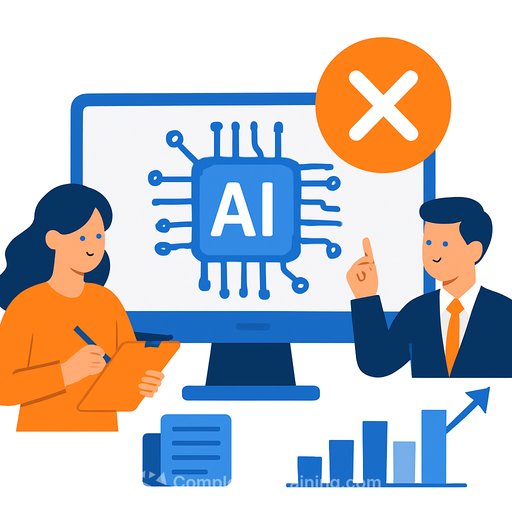Can You Use AI To Write For YMYL Sites? Read This Before You Hit Publish
If your content touches health, finance, legal, safety, or major life decisions, you're in YMYL territory. Google turns the dial way up on scrutiny here-and for good reason. This is where advice can harm people, drain savings, or cost rights.
AI can help you work faster. But there's a difference between help and authorship. The evidence shows large models miss critical details, flatten nuance, and create sameness-exactly where original expertise matters most.
Why Google Treats YMYL Differently
Google's own guidance is blunt: YMYL needs "very high Page Quality" and the highest scrutiny. For these queries, the systems give more weight to expertise, authoritativeness, and trust signals.
In the March 2024 core update, Google aimed to reduce low-quality results by ~40%, with finance and health sites feeling the heat first. If your content is generic, undifferentiated, or light on real expertise, you're fighting gravity.
See Google's March 2024 update notes
The Evidence: AI Misses Where It Matters
Health
A Stanford HAI study found 30% of individual statements from GPT-4 with RAG were unsupported, and nearly half of responses had at least one unsupported claim. One test produced instructions for the wrong medical equipment-a mistake that could harm someone in an emergency.
A well-known men's magazine tried an AI-written health article. A physician flagged 18 errors: misused terms, unsupported links between diet and symptoms, and overconfident warnings. It sounded plausible-and that's the danger.
Finance
Money.com tested 100 financial questions. Results: 65% correct, 29% incomplete or misleading, 6% wrong. The system cited weak sources, skipped rule changes, and didn't warn against classic mistakes like trying to time the market.
Legal
Stanford's RegLab found hallucinations in 69% to 88% of legal queries for current models. On court holdings, models hallucinated at least 75% of the time. There's now a public record of hundreds of legal filings that included AI-made fabrications.
What Google Rewards That AI Can't Replicate
Google added "Experience" to E-E-A-T for a reason. It's not enough to be accurate-you need first-hand depth. Real cases. What typically works. What to expect. Where the risk hides. The stuff you only learn by doing.
AI can define TMJ. A specialist can explain recovery timelines, common patient mistakes, and when you should see a provider-not just any provider, the right one. That's the difference readers and algorithms pick up on.
The Homogenization Trap
LLMs predict the most probable next word. That pulls content toward the average. Studies show this "death spiral of homogenization" reduces the diversity of ideas across a group, even if it boosts individual output.
In YMYL, sameness kills your edge. If three advisors ask a model for the same article, they'll publish three versions of the same post. No fresh insight. No reason to rank. No reason to trust.
How Google Checks If The "Author" Is Real
Google connects bylines to real reputations. Doctors with board listings and publications, attorneys with bar records, advisors with FINRA entries-these create patterns the systems recognize.
Style, terminology, depth, and focus form a signature. If an article under your name reads nothing like your past work, that's a signal. Tighten the chain: link bylines to rich bio pages, list credentials and jurisdictions, and connect to verifiable profiles. Most importantly, have the expert write or thoroughly review the draft so the voice and insight are genuine.
Practical Workflow For Writers Covering YMYL
Your defensible process
- Define scope and risks: Who could be harmed by this content? Where do people misinterpret advice?
- Source stack: primary guidelines, laws, peer-reviewed research, official agencies, and current rule changes.
- Expert input first: interview a practitioner; extract lived experience, case patterns, and decision criteria.
- Outline for decisions: what to do, when to act, thresholds, alternatives, and trade-offs.
- Draft with citations in-line. Avoid vague phrasing; quantify where possible.
- Expert review pass: correctness, nuance, omissions, and real-world caveats.
- Compliance pass: disclaimers, scope limits, jurisdiction notes, and "last reviewed" date.
- Authorship signals: byline links, credentials, relevant cases, and prior work.
Safe ways to use AI (support, not authorship)
- Interview prep: generate targeted questions to extract expert stories and decision rules.
- Structuring: turn messy notes into a clean outline; create comparison checklists and FAQs.
- Editing passes: clarity, consistency, and format. Never accept factual changes without source checks.
- Gap scans: ask, "What would a specialist add that's missing?" then confirm with the expert.
- Ops: transcription, style normalization, schema suggestions, and version control summaries.
Do not outsource these to AI
- Diagnoses, investment advice, legal interpretations, or any step that changes real outcomes.
- Source selection and claims. You pick sources; you verify claims.
- Conclusions and thresholds ("do X if Y"). Those must come from qualified humans.
Risk, Compliance, And Ethics
- Maintain a claims log: every strong statement ties to a source or a named expert.
- Add "last reviewed" dates and change notes for YMYL pages.
- Use plain-language disclaimers and jurisdiction limits where relevant.
- Run a red team pass: "How could this advice go wrong?" Patch the holes.
- Keep proofs: expert approvals, source archives, and editorial checklists.
What Readers Actually Want
They don't want definitions; they want judgment. What to expect, what usually works, what to avoid, and when to seek help. Stories from the field beat summaries of summaries.
Write like a practitioner talking to a smart friend. Short answers, real thresholds, and honest uncertainty. That's how trust is built.
Strategy For Writers And Editors
- Differentiate with experience: lead with cases, mistakes, and decision trees only a pro would know.
- Be specific: numbers, ranges, timelines, and exceptions. Vague advice looks like it was assembled by a bot.
- Consolidate authority: one excellent, maintained guide beats ten thin pages.
- Make review part of the product: schedule updates, not just one-time publish.
- Treat AI as an assistant for structure and speed-never the author on YMYL.
Looking Ahead
The upside in YMYL isn't volume-it's credibility. Publishers that chase scale with generic AI content will keep getting filtered out. The ones that invest in first-hand expertise will keep compounding trust and rankings.
Use AI where it helps you think and organize. Don't let it speak for you where lives, money, or rights are on the line.
Want to use AI the right way in your writing workflow?
Check practical tools and tactics for writers here: AI tools for copywriting and role-based picks here: courses by job. Keep the human judgment; let the tools handle the grunt work.
Your membership also unlocks:






